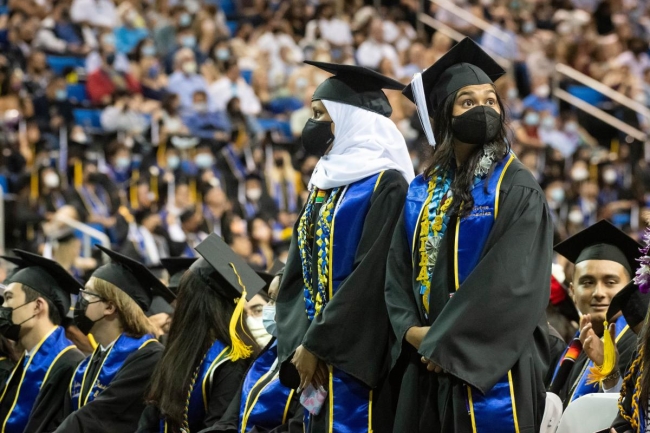You have /5 articles left.
Sign up for a free account or log in.

Students at UCLA’s 2022 commencement ceremony on June 10 were (largely) masked after the university reinstated its indoor mask mandate in response to the latest COVID outbreak.
Sarah Reingewirtz/Los Angeles Daily News/Getty Images
California colleges and universities are feeling the full impact of the latest COVID-19 outbreak.
Over the past two months, a new hypertransmissible variant, BA5, has hit the Golden State hard. The state’s seven-day average case rate rose from around 5,000 in late April to over 20,000 last week, according to state and local data aggregated by The New York Times.
Los Angeles County has felt the brunt of the surge; the average daily case rate there increased almost tenfold from March to July, and daily deaths from COVID have almost doubled in the past month.
Colleges and universities in L.A. County are responding with a range of mitigation measures, which include encouraging—and in some cases, requiring—mask wearing on campus.
In late May, the University of California, Los Angeles, reinstated its indoor mask mandate after lifting it just over a month earlier. The University of California, Irvine, did the same just last week; in Orange County, where it’s located, the CDC reported transmission levels have risen from medium to high.
David Souleles, director of UC Irvine’s COVID-19 response team, said that most students and faculty on campus for summer session are respecting the mask mandate. He said it’s unclear whether the university will keep the mandate in place for the fall, but he hopes people on campus continue to wear masks regardless.
“You’re never going to have 100 percent compliance, but I’ve been seeing very good compliance here,” he said. “Masking is a polarizing issue, but generally speaking people at UC Irvine get that our goal is to keep people as safe as possible.”
Other colleges in the area, including the University of Southern California, have not yet restored a mask mandate. Dr. Sarah Van Orman, chief health officer for student affairs at the USC, said the university would do so if L.A. County issued a mask mandate—which appears likely to happen as soon as this week.
Anita Barkin, co-chair of the American College Health Association’s COVID-19 task force, said that masking indoors is a “proven effective measure” to mitigate the virus’s spread. But between the decreased severity of most infections and general pandemic fatigue, she added, many people do not feel the same urgency they felt even six months ago during the Omicron surge—especially in states that have been less committed to masking than California.
“It’s going to be difficult for most schools to implement a masking strategy like they had early on in the pandemic,” she said. “There’s not a lot of will to continue that mitigation strategy, and I think leaders are reluctant to return to those more restrictive policies.”
Same Challenges, New Solutions
Dr. Van Orman, who also sits on the ACHA COVID task force, said after years of dealing with the pandemic, institutions have had time to develop effective measures to mitigate transmission.
She said in addition to masking in indoor settings, improved indoor ventilation and air quality and widely available vaccines and antiviral treatments like Paxlovid are valuable weapons in the battle against COVID. California institutions, she said, are “on the vanguard” of the fight against the new variant.
“We are in a very different place than we were two and a half years ago,” she said. “We have an armory of tools to help us combat this.”
At the same time, many institutions have loosened COVID restrictions and scaled back some of the infrastructure built early in the pandemic to deal with much higher caseloads. Many colleges have stopped or significantly decreased surveillance testing of students, once considered a crucial tool in their COVID tracking and mitigation arsenal.
“The testing infrastructure has definitely shrunk over time,” Souleles said. “Many of us were doing significant surveillance testing on large portions of our population as recently as a year ago. Most of us are not doing that anymore.”
Dr. Van Orman said that with at-home antigen kits the primary means of testing, universities’ strategies for tracking transmission will have to evolve. That might mean turning to other strategies like regular wastewater testing to ensure that increases in transmission are caught early, she said.
“It’s much more tricky to track transmission now,” she said.
One strategy that Dr. Van Orman doesn’t expect to make a comeback is widespread remote learning. She said that while individual students or faculty members might make the choice to go remote for periods of time, the days of empty classrooms are likely a relic of the past.
“I really don’t see universitywide remote learning as being on the table,” she said. “We have all these other tools where I don’t think we need to do that.”
‘What’s the Long Game?’
As they deal with the newest wave of infections, universities in California are evaluating their mitigation strategies to make them as sustainable and nondisruptive as possible.
“One of the big questions not just for higher ed but for the country is, what’s the long game? Nobody thought we’d still be dealing with this two and a half years later,” Souleles said. “So we’re thinking about what does that mean, and what kind of systems need to be in place for the long term?”
UC Irvine still maintains 166 beds for isolation housing, which is about half the bed space made available when the system was first set up. Souleles said there’s no plan to stop offering beds for quarantining in the near future, but he conceded that with housing already limited at many institutions, offering them in perpetuity might not be realistic, either.
“It’s a fairly expensive proposition. And for campuses that aren’t using hotels or other options, you’re cutting into the beds available for students, and many of us work really hard to make sure we have as much housing available on campus as possible,” Souleles said. “But we still felt that given the current public health guidelines, we need to maintain isolation beds at least for this academic year.”
Dr. Van Orman said that institutions will have to be prepared to respond to serious outbreaks while also maintaining in-person classes and undisrupted education. She said that means developing more “continuity infrastructure” for when faculty and staff get sick or exposed, as well as effectively communicating with students and other community members.
“That doesn’t just mean innovation in mitigation strategies—it’s also logistics and communication, letting people know that we can live with this while protecting our most vulnerable,” she said. “We are working to figure out how we make this a part of daily life … it’s not a dismantling, but rather a refinement.”
Barkin said that it’s important for institutions to consider sustainable strategies for mitigation into the future, for when—or perhaps if—the pandemic nature of COVID-19 morphs into an endemic state. But she does not believe we’re there yet.
“When we talk about endemicity, we’re talking about a low level of ongoing infection, we’re not looking at huge outbreaks, so things can be handled more on an individual basis,” she said. “But that’s going to depend on how severe future variants are … this pandemic certainly has thrown some curveballs and continues to do so.”
Souleles agreed. He said that as long as public health guidance recommends treating the virus with more seriousness and urgency than, say, a flu outbreak, UC Irvine will continue to offer extra support like isolation housing and testing sites.
“We’re all tired. We all just want it not to be like this anymore,” he said. “But we recognize there are things we really need to do to ensure the health of our whole community.”





